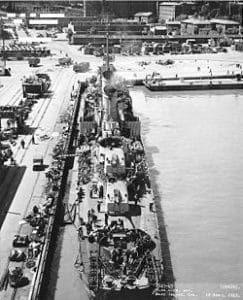Mare Island Naval Shipyard was a U.S. Naval shipyard that repaired and built vessels during World War I and World War II. Mare Island used asbestos, leading to exposure in workers and the risk of mesothelioma and asbestos-related lung cancer in workers and veterans.
If you or a loved one have been diagnosed with mesothelioma, asbestos-related lung cancer, or asbestosis, you may be eligible for substantial compensation. There is currently over $30 billion in asbestos trust funds set up for victims of asbestos-related diseases. We invite you to fill out our form today for a free Financial Compensation Packet, filled with information about experienced mesothelioma lawyers in your area, how to get paid in 90 days, how to file an asbestos trust fund claim, and much more.


FREE Financial Compensation Packet
- Info on law firms that will recover your HIGHEST COMPENSATION
- Learn how to get paid in 90 days
- File for your share of $30 billion in trust funds

Did Mare Island Naval Shipyard Use Asbestos?
Mare Island Naval Shipyard used asbestos in its operations for decades. Like other shipyards, both naval and civilian, asbestos was prevalent. It was found in hundreds of components that went into building ships.
Shipyards like Mare Island used asbestos for its insulating properties and ability to fireproof effectively. It was also readily available and cheap.
Mare Island Naval Shipyard History
Established in 1854, Mare Island Naval Shipyard was the first West Coast Naval base established in Vallejo, California. The area’s name comes from General Mariano Guadalupe Vallejo, a cavalry commando from Mexico who founded that area in the 1700s.
During the mid-1800s, the first dry dock and the first U.S. warship were built at the Mare Island Naval shipyard. The ship was the USS Saginaw, the first of nearly 500 ships built at the shipyard in its long history.
In 1910, Mare Island built the first aircraft landing deck, a wooden platform on the USS Pennsylvania. Mare Island workers still hold a record for building the USS Ward, a destroyer, in just under 18 days during World War I.
Mare Island in World War II
Shipbuilding activity surged at Mare Island as World War II began. The shipyard built hundreds of vessels for the war, including landing crafts, submarines, destroyer escorts, and submarine tenders.
Mare Island also played an important role in receiving and repairing damaged ships during the war. The number of civilians employed at Mare Island peaked during this time at nearly 39,000.
Post-War Years
Mare Island remained vital in ship repair for the U.S. Navy after World War II. The primary focus was on repairing and updating submarines.
The shipyard continued building submarines, including the first nuclear submarine on the West Coast, the USS Sargo. This was one of several nuclear-powered submarines constructed here.
With its expertise in nuclear submarines, Mare Island opened the Nuclear Power School. It trained workers to build and operate nuclear-powered vessels. Mare Island built its last submarine in 1970.
The Closure of Mare Island Naval Shipyard
Mare Island Naval Shipyard was recommended for closure in 1993 and closed in 1996. The reasons for its closure included a reduced need for nuclear-capable facilities and the ongoing costs of dredging the area around the shipyard.
Mare Island today is a mixture of public spaces, commercial businesses, and industrial sites. Several businesses, organizations, and government agencies own different areas of the property.
How Did Mare Island Naval Shipyard Use Asbestos?
Mare Island Naval Shipyard relied heavily on asbestos when building vessels and repairing ship parts. Additionally, asbestos could be found in buildings, equipment, and vehicles.
Hundreds of components that went into building and repairing ships at Mare Island contained asbestos, including:
- Insulation
- Pipes
- Cement
- Wall panels
- Boilers
- Gaskets
- Valves
- Textiles
Who Was Harmed by Asbestos at Mare Island Naval Shipyard?
Pipefitters, mechanics, insulators, maintenance workers, and many other employees and contractors were exposed to asbestos daily while doing routine work activities.
Most workers were never given protective gear, which heightened the risk of developing asbestos-related diseases. They were also exposed to other dangerous materials, including pesticides, lead-based paint, and petroleum fuels.
Many employers and contractors developed asbestos-related illnesses, including malignant mesothelioma, asbestos-related lung cancer, and asbestosis.
Many asbestos-related lawsuits followed after workers became ill. The plaintiffs, mostly retired Naval workers, generally filed their claims against the asbestos manufacturers that provided asbestos-containing products to the shipyard.
Lingering Contamination at Mare Island Shipyard
Over 100 years of building and repairing ships with toxic materials like asbestos, the shipyard left a mark on the area. When Mare Island closed, it left hundreds of thousands of tons of contaminating substances behind.
Massive cleanup was required to redevelop the area. Some sites are complete, but the project is ongoing. The site includes contaminated soil, spill sites, explosives and munitions, and contaminated groundwater.
Mare Island Naval Shipyard Today
Currently, the shipyard is being used and leased out by commercial and industrial businesses, including the California Conservation Corps and numerous other prominent organizations.
Additionally, the U.S. Navy developed the “economic development conveyance” on the shipyard to convert the BRAC into civilian communities. It also transferred many of the shipyard’s properties to multiple government agencies.
The shipyard’s island buildings were also used as a set for several Hollywood movies, including Jack, Metro, Sphere, and Flubber.
Compensation for Workers Exposed to Asbestos at Mare Island
If you worked at Mare Island, you could be at risk for asbestos illnesses. A mesothelioma lawyer can help you understand your rights and seek compensation.
One option may be to file a lawsuit. While you cannot sue the military or government, you can seek damages from the asbestos companies that supplied Mare Island. Both veterans and past civilian workers can file a lawsuit to seek a settlement or a jury award.
Companies that went bankrupt cannot be sued. These companies set up trust funds to compensate victims. They serve as an alternative to filing a lawsuit. Some of the companies that supplied Mare Island and that have active asbestos trust funds include:
- Armstrong
- Combustion Engineering
- Fibreboad
- Flexitalic
- Keene Corporation
- Owens Corning
- Pittsburgh Corning
- Turner & Newall
- Western MacArthur
Veterans can also file claims for VA benefits. These include monthly disability payments, special compensation, benefits for dependents, and medical care.
Additional Resources and Help for Asbestos Victims
If you’ve been injured by mesothelioma, asbestos-related lung cancer, or asbestosis, keep in mind that there is a good chance that you’ll qualify for considerable compensation. Don’t forget to fill out our form to get our free Financial Compensation Packet, filled with information on the experienced asbestos and mesothelioma attorneys. If you have questions or need additional assistance, contact us at 800-793-4540.

Paul Danziger
Reviewer and EditorPaul Danziger grew up in Houston, Texas and earned a law degree from Northwestern University School of Law in Chicago. For over 25 years years he has focused on representing mesothelioma cancer victims and others hurt by asbestos exposure. Paul and his law firm have represented thousands of people diagnosed with mesothelioma, asbestosis, and lung cancer, recovering significant compensation for injured clients. Every client is extremely important to Paul and he will take every call from clients who want to speak with him. Paul and his law firm handle mesothelioma cases throughout the United States.
References
- National Park Service. (n.d.). National Register of Historic Places Inventory – Nomination form. Mare Island Naval Shipyard.
Retrieved from: https://npgallery.nps.gov/NRHP/GetAsset/NHLS/75002103_text - Hedley-White, J. and Milamed, D.R. (2008, September). Asbestos and Ship-Building: Fatal Consequences. Ulster J. Med. 77(3), 191-200.
Retrieved from: https://www.ncbi.nlm.nih.gov/pmc/articles/PMC2604477/ - U.S. Environmental Protection Agency. (2023, August 8). Asbestos Laws and Regulations.
Retrieved from: https://www.epa.gov/asbestos/asbestos-laws-and-regulations - Visit Vallejo California. (n.d.). Mare Island History.
Retrieved from: https://www.visitvallejo.com/about-vallejo/mare-island-history - Pedroncelli, R. (1996, October). Good-Bye Mare Island. U.S. Naval Institute.
Retrieved from: https://www.usni.org/magazines/naval-history-magazine/1996/october/good-bye-mare-island - ProPublica. (2017, December 5). Mare Island Naval Shipyard.
Retrieved from: https://projects.propublica.org/bombs/installation/CA9170024775001700
